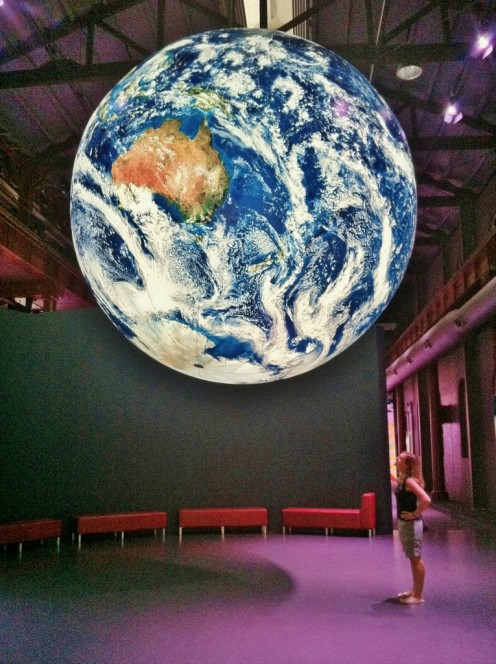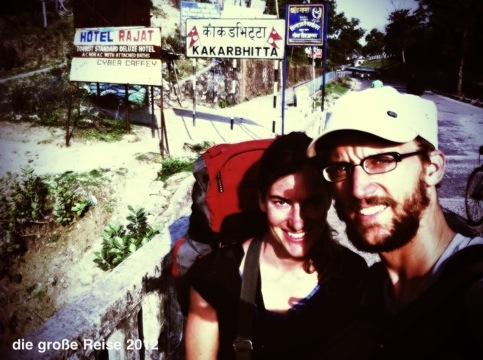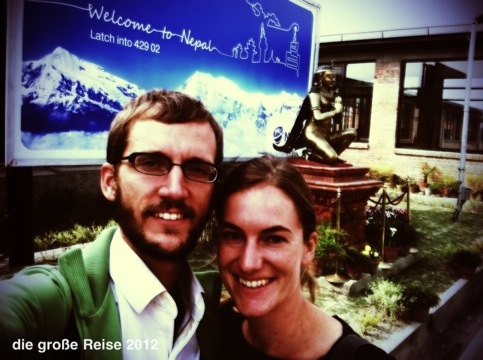Stations #66
Kopflos
 Die unglaublichste Geschichte aus Kalkutta ist die der Ziegen von Kalighat. Als heiligster Hindutempel der Stadt ist er eigentlich jeden Tag vollgepackt mit Menschen, die stundenlang anstehen, um im Inneren eine Statue von Kali zu verehren, die dreiköpfige schwarze Göttin der Ewigkeit und des Todes.
Die unglaublichste Geschichte aus Kalkutta ist die der Ziegen von Kalighat. Als heiligster Hindutempel der Stadt ist er eigentlich jeden Tag vollgepackt mit Menschen, die stundenlang anstehen, um im Inneren eine Statue von Kali zu verehren, die dreiköpfige schwarze Göttin der Ewigkeit und des Todes.
Wie viele andere religiöse Bauwerke die wir bisher gesehen haben, hat auch Kalighat einen Opferstock. Der einzige Unterschied zu allen anderen Tempeln ist, dass hier selbst heute noch jeden Tag lebende Tiere geopfert werden. In langen Schlangen warten die Gläubigen auf die Chance ihre Ziege hinrichten zu lassen – im Austausch gegen das Wohlwollen der Todesgöttin. Als hätte die Aufklärung nie stattgefunden. Unter Trommeln werden die mit Blumenketten geschmückten Tiere in den Opferraum geführt und mit Weihwasser gesegnet. Nach der Enthauptung malen die Henker mit dem frischem Blut Weiterlesen
Favourite Shot
Late afternoon at the Victoria Memorial, Calcutta.
It’s one of the biggest colonial monuments in Calcutta. The British inaugurated it in 1921 as a tribute to the success of the British Empire in India, and dedicated it to Victoria, the Queen of the United Kingdom and Empress of India.
Mother Teresa’s halo
 For Westerners, one figure that is associated with Calcutta more than anyone else is Mother Teresa. This tiny woman, born into an Albanian family in 1910, felt God’s calling and left everything behind to become a very passionate missionary. She joined the Sisters of Loreto 1928 in Ireland, and soon afterwards arrived in Calcutta. She then had a vision in which God apparently told her to found her own order, and take care of the poorest. She followed the divine command, and from 1950 the ‚Missionaries of Charity‘, as the new order was named, started to care for the poorest of the poor – of which there are many in the most sprawling urban conglomerate on earth. Weiterlesen
For Westerners, one figure that is associated with Calcutta more than anyone else is Mother Teresa. This tiny woman, born into an Albanian family in 1910, felt God’s calling and left everything behind to become a very passionate missionary. She joined the Sisters of Loreto 1928 in Ireland, and soon afterwards arrived in Calcutta. She then had a vision in which God apparently told her to found her own order, and take care of the poorest. She followed the divine command, and from 1950 the ‚Missionaries of Charity‘, as the new order was named, started to care for the poorest of the poor – of which there are many in the most sprawling urban conglomerate on earth. Weiterlesen
Stations #65
Über lebende Brücken
 Manchmal staune ich, auf was für Ideen Menschen so kommen. Ein außergewöhnliches Beispiel menschlicher Kreativität bot sich uns in der Nähe von Cherrapunjee. Die kleine Stadt, die unter den Einheimischen als Sohra bekannt ist (ihr ursprünglicher Name vor Kolonialzeiten) liegt in Meghalaya. Das ist einer von sieben kleinen Bundesstaaten im indischen Nordosten, dem Landesteil zwischen Myanmar, Bhutan, Bangladesh und China, der nur durch einen schmalen Korridor mit dem Rest von Indien verbunden ist. Also nicht gerade der zentralste Ort auf dem Touristenhighway – dementsprechend ruhig war es dort, außer ein paar indischen Urlaubern niemand vom Stamm der Backpacker zu sehen. Für uns lag es aber genau auf dem Weg: unsere Reiseroute geht ganz einfach da lang, wo es schön und besonders ist. Weiterlesen
Manchmal staune ich, auf was für Ideen Menschen so kommen. Ein außergewöhnliches Beispiel menschlicher Kreativität bot sich uns in der Nähe von Cherrapunjee. Die kleine Stadt, die unter den Einheimischen als Sohra bekannt ist (ihr ursprünglicher Name vor Kolonialzeiten) liegt in Meghalaya. Das ist einer von sieben kleinen Bundesstaaten im indischen Nordosten, dem Landesteil zwischen Myanmar, Bhutan, Bangladesh und China, der nur durch einen schmalen Korridor mit dem Rest von Indien verbunden ist. Also nicht gerade der zentralste Ort auf dem Touristenhighway – dementsprechend ruhig war es dort, außer ein paar indischen Urlaubern niemand vom Stamm der Backpacker zu sehen. Für uns lag es aber genau auf dem Weg: unsere Reiseroute geht ganz einfach da lang, wo es schön und besonders ist. Weiterlesen
Favourite Shot

Golden Langur on Umananda Island, Guwahati, Assam. Highly endangered primate species that is only found in Assam and parts of Bhutan. Lucky we spotted one of these furry creatures!
Stations #64
Coming up: India, Emirates, Africa
 Like us, our travel plans are always on the move. Every now and then we get hooked on some ideas… now we have a rough itinerary for the next 2-3 months in mind, so if you have any travel tips for those areas, things not to miss or places to avoid, let us know!
Like us, our travel plans are always on the move. Every now and then we get hooked on some ideas… now we have a rough itinerary for the next 2-3 months in mind, so if you have any travel tips for those areas, things not to miss or places to avoid, let us know!
After Calcutta, Varanasi and Delhi we plan a short visit to the North of India, mostly Dharamsala and Amritsar. And this time we want to see the famous Ellora and Ajanta caves near Aurangabad.
From Mumbai we plan to catch a low-cost flight to Sharjah (Air Arabia) and explore the Arab Emirates for a week or so, we’re especially keen on Dubai, Abu Dhabi and the Hormuz Strait.
The next big destination is Africa and we want to take some more time there than initially planned. Roaming around Ethiopia from Addis Ababa, then Kenya, Uganda, through Tanzania to Mozambique and if possible on to South Africa, Namibia and Botswana. We might even skip South America for that.
If you’re in the same area some time soon let us know and we can meet up!
The camera is dead, long live the camera
One day in the Sikkimese mountains, our camera made its last shot. It came as a shock but was on the other hand not completely unexpected: the EOS 1000D that we had bought a few years earlier finally surrendered to the heat and cold, dust and humidity, salt-water spray and other shocks while bumping around the world. It was a great camera to start out with digital SLR photography and a good travel companion. In Darjeeling there was nobody that could have checked or even repaired any fault so we had to look for a new one if we didn’t want to miss taking pics of the rhinos. I wanted to take this opportunity to pack all the photography nerdiness we accumulated during our travels so far into the following paragraphs, so if you aren’t into SLR, EOS and EFS, just jump to the rhinos we captured with all this kit in Jaldapara National Park.
Since the beginning of our journey we were using a Weiterlesen
Stations #63
Where the wild rhinos live
 Spotting wild rhinos while riding on an elephant? We were intrigued. In a remote corner of West Bengal, in a wildlife sanctuary called Jaldapara, it’s possible to do exactly that. Since 1941 the forest area is a protected habitat for wild rhinos, one of the last places in India where you can see these impressive creatures in their natural surroundings.
Spotting wild rhinos while riding on an elephant? We were intrigued. In a remote corner of West Bengal, in a wildlife sanctuary called Jaldapara, it’s possible to do exactly that. Since 1941 the forest area is a protected habitat for wild rhinos, one of the last places in India where you can see these impressive creatures in their natural surroundings.
A bumpy four-hour bus ride from Siliguri, Weiterlesen
The end of the road
 India has lots of well-known tourist highlights, such as the Red Fort in Delhi, the Taj Mahal in Aggra, the beaches in Goa or backwaters in Kerala. Fortunately we’ve seen a few of those most crowded places already. So this time we wanted to focus on lesser known places, and Sikkim is the first of them. It is the Indian state squeezed into the political danger zone between China, Nepal, Bhutan and Bangladesh. It’s the least populous state yet full of mountains, including the world’s third highest (Kanchenjunga at 8586m) and the people that are living there are seriously some of the nicest in India – less intrusive, less nosy, more polite and very helpful. Weiterlesen
India has lots of well-known tourist highlights, such as the Red Fort in Delhi, the Taj Mahal in Aggra, the beaches in Goa or backwaters in Kerala. Fortunately we’ve seen a few of those most crowded places already. So this time we wanted to focus on lesser known places, and Sikkim is the first of them. It is the Indian state squeezed into the political danger zone between China, Nepal, Bhutan and Bangladesh. It’s the least populous state yet full of mountains, including the world’s third highest (Kanchenjunga at 8586m) and the people that are living there are seriously some of the nicest in India – less intrusive, less nosy, more polite and very helpful. Weiterlesen
Stations #62
Hauptquartier der Bürokratie – eine indische Komödie
Deutschland ist bürokratisch, England gleich dreimal. Indien? Hat wohl das kolonialistische Erbe der Engländer weiterentwickelt und spielt was Bürokratie angeht in einer eigenen Liga. Die Ironie dabei ist, dass das Land insgesamt total chaotisch ist – und trotzdem jede Transaktion mit Durchschlag in dreifacher Ausfertigung quittiert wird. Ob hier versucht wird das allgemeine Chaoslevel zu reduzieren oder vielleicht eher zu kompensieren bleibt fraglich. Hier ist eine von vielen Anekdoten aus dem Hauptquartier der Bürokratie.
Erstmal zu den Hauptakteuren in diesem Theater: Sekretäre, Offiziere, Büroangestellte, Polizisten, Hotelmanager. Ihnen allen ist gemeinsam, dass ihnen langweilig ist. Wenn man die heiligen Hallen ihres Wirkens betritt, die sich normalerweise als runtergekommene spärlich möblierte Büros darstellen, schauen sie, die Bürokraten der Nation, normalerweise fern, wenn sie Internet haben surfen sie auf facebook, oder sie kauen Tabak und meditieren den Lauf der Dinge. Es ist uns aber auch schon passiert Weiterlesen
Zurück in Indien
 Fünf Jahre nach meinem Studienaufenthalt in Delhi bin ich also zurück in Indien. Wir laufen über eine lange Brücke vom nepalesischen Kakarvitta in ein namenloses indisches Grenzdorf, keine Schranke, kein Zaun, kein Tor – eigentlich auch keine Stadt. Aber plötzlich verkaufen Straßenstände Chai und Samosa, versuchen Fahrradrikschafahrer und Busschaffner dir ihre Dienste aufzuschwätzen – Indien eben. Den Grenzposten müssen wir suchen, er steht etwa 100m weg von der Straße in einem kleinen Palmenhain – ein paar weisse Unterhemden hängen auf einer Leine. Ein einsamer Soldat sitzt drinnen und Weiterlesen
Fünf Jahre nach meinem Studienaufenthalt in Delhi bin ich also zurück in Indien. Wir laufen über eine lange Brücke vom nepalesischen Kakarvitta in ein namenloses indisches Grenzdorf, keine Schranke, kein Zaun, kein Tor – eigentlich auch keine Stadt. Aber plötzlich verkaufen Straßenstände Chai und Samosa, versuchen Fahrradrikschafahrer und Busschaffner dir ihre Dienste aufzuschwätzen – Indien eben. Den Grenzposten müssen wir suchen, er steht etwa 100m weg von der Straße in einem kleinen Palmenhain – ein paar weisse Unterhemden hängen auf einer Leine. Ein einsamer Soldat sitzt drinnen und Weiterlesen
This was Nepal
21 Nepal, a set on Flickr.
a love affair with the Himalayas
Stations #61
On top of the world
 April 23, 2012 – hard to believe it’s already been a year since our wedding. Thanks for the good wishes on our first anniversary! As opposed to our usual austerity policy regarding our travel budget, Julia and me treated ourselves to something special to celebrate the occasion: a scenic flight to Everest. So from Kathmandu the BAE Jetstream – a 29 passenger aircraft – rose to about 6000m and headed east. Below us the misty valleys of the lower Himalayas, on the left rock faces and glacier caps of some of the highest mountains in the world and on the horizon in front
April 23, 2012 – hard to believe it’s already been a year since our wedding. Thanks for the good wishes on our first anniversary! As opposed to our usual austerity policy regarding our travel budget, Julia and me treated ourselves to something special to celebrate the occasion: a scenic flight to Everest. So from Kathmandu the BAE Jetstream – a 29 passenger aircraft – rose to about 6000m and headed east. Below us the misty valleys of the lower Himalayas, on the left rock faces and glacier caps of some of the highest mountains in the world and on the horizon in front
Favourite Shot
Human cremation at Pashupatinath Temple in Kathmandu. The ashes are pushed into the Bagmati River, which is considered sacred by Hindus as it flows into the holy river Ganges.
Quite something to see a Hindu funeral ceremony for the first time!
Sonnenschein im Annapurna Base Camp
 Yaksteak und jede Menge Apfelkuchen, stundenweiser Aufenthalt in den heissen Quellen – so füllen wir während unserem Pausentag in Tatopani unsere Energiereserven wieder auf. Am nächsten Tag dann der extrem steile Aufstieg zu einem Grat namens Khopra Danda: 2400 Höhenmeter an einem Tag. In erstaunlich guter Verfassung kommen wir in der Hütte oben in Khopra an, grade noch bevor es anfängt zu hageln.
Yaksteak und jede Menge Apfelkuchen, stundenweiser Aufenthalt in den heissen Quellen – so füllen wir während unserem Pausentag in Tatopani unsere Energiereserven wieder auf. Am nächsten Tag dann der extrem steile Aufstieg zu einem Grat namens Khopra Danda: 2400 Höhenmeter an einem Tag. In erstaunlich guter Verfassung kommen wir in der Hütte oben in Khopra an, grade noch bevor es anfängt zu hageln.
Around Annapurna
 When we left for our trip around the world, we didn’t have a fixed itinerary, rather a whole bunch of ideas. Going hiking in the Himalayas was one of them. However, it wasn’t until we met Dustin, an American traveller, on a cross-border train from Mongolia into China, that we first heard about the Annapurna Circuit. After listening to his glowing accounts of this long-distance trek in central Nepal, the idea was born that night in July, while we rattled through the Gobi desert, that the Annapurna Circuit sounded like a challenge we would love to take on.
When we left for our trip around the world, we didn’t have a fixed itinerary, rather a whole bunch of ideas. Going hiking in the Himalayas was one of them. However, it wasn’t until we met Dustin, an American traveller, on a cross-border train from Mongolia into China, that we first heard about the Annapurna Circuit. After listening to his glowing accounts of this long-distance trek in central Nepal, the idea was born that night in July, while we rattled through the Gobi desert, that the Annapurna Circuit sounded like a challenge we would love to take on.
Fast forward: almost ten months later, we arrive in Kathmandu. Weiterlesen
Stay warm
 Sleeping bags can be incredibly expensive. Getting a branded one with goose down can easily set you back some 400-500€. Thanks to our French friends at Decathlon though I had gotten one for less than 100€ that claims to keep you warm even in temperatures slight below zero.
Sleeping bags can be incredibly expensive. Getting a branded one with goose down can easily set you back some 400-500€. Thanks to our French friends at Decathlon though I had gotten one for less than 100€ that claims to keep you warm even in temperatures slight below zero.
Down is lighter, smaller and warmer than most cheap synthetic materials, however as soon as it gets humid or even wet it looses pretty much all of its insulation properties. On a trip where we wouldn’t need the sleeping bags on most nights we could only take something small and lightweight. Be it camping in New Zewland’s frosty spring nights, and especially now in Nepal at higher altitude, I was happy about having taken that 1 extra kg.
See you on the other side
We have moved on to Nepal by now, and from tomorrow we will be undertaking a long trek in the Himalayas – the famed 300km long Annapurna Circuit. So there won’t be any updates from us here in the next two to three weeks, but I am sure we will have more than one story to tell when we are back. Until then: happy Easter (and chag sameach to our Israeli friends)!



































